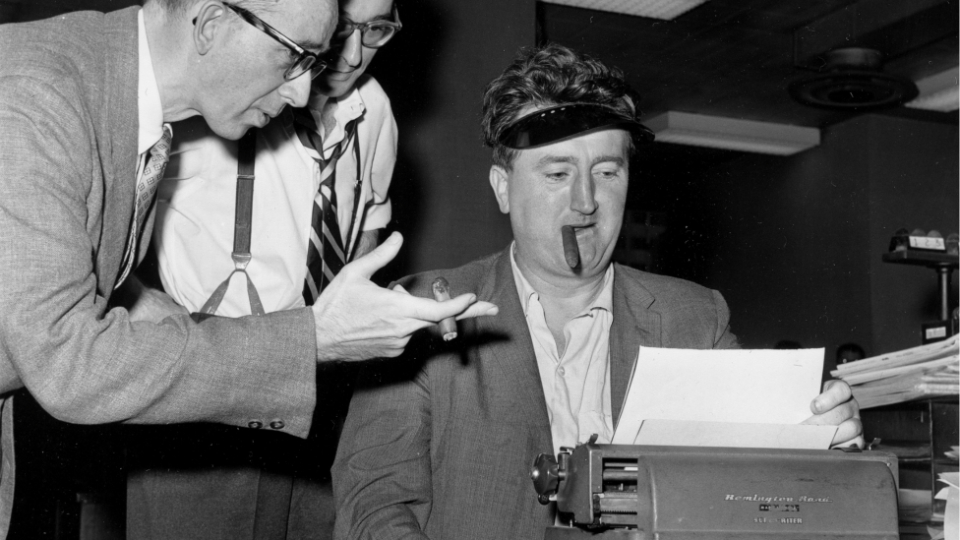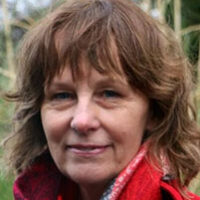
Brendan Behan was arguably one of the last writers to emerge from the Irish literary revival movement. This originated in the 1880s, initiated within the Protestant Ascendency class, by Douglas Hyde, W.B. Yeats, Augusta Gregory, and J.M. Synge, and spread out into the Irish working class with such literary giants as Sean O’Casey, Máirtín Ó Cadhain and Liam O’Flaherty. This literary revival coincides in its origins with the growth of Irish nationalism in the 19th century, developing into the socialism of James Connolly. A great many writers in both English and Irish became part of it.
Behan was born after the foundation of the Irish Free State, on February 9, 1923, into a self-educated, working-class family of house painters. The Irish civil war was raging and Behan’s people sided with the Republicans. They were deeply imbued with culture and the arts, and Behan was plunged into this literary tradition. One of Behan’s uncles, his mother’s brother Peadar Kearney, wrote “A Soldier’s Song” in 1910, which was fast adopted by the liberation movement and which in 1926 became the national anthem of Ireland. This bespeaks not only the powerful political grounding Behan and his brothers received but also how they grew up in the popular ballad tradition.
In Borstal Boy, Behan recalls his father’s songs and that he “was a great fiddler and so was my uncle, my mother’s brother, who had a fiddle presented to him by the prisoners in Ballykinlar Internment Camp for writing the National Anthem. My mother was a good singer, and my stepbrother’s aunts were pianists, and great nights we had in their big house on the North Circular Road.”
Another uncle, P.J. Bourke, was involved in the Irish theatre movement. The Behan family exemplifies just how interwoven the national liberation movement was with the literary revival. Like the majority of his generation (before free secondary education came into force decades later), Behan left national school aged thirteen and became apprenticed to a house painter, his father’s and grandfather’s trade.
A significant factor in Behan’s life was his close friendship with his cousin Cathal Goulding, who was the same age and who shared much the same biography (house painter, Fianna, IRA, prison, etc.).
Behan’s father Stephen had fought in the war of Independence and passed on his love for literature and reading to his children. His mother Kathleen (a member of Cumann na mBan, an Irish republican women’s paramilitary organization) was equally well read and cultured, with a great store of songs, and remained politically active all her life. She had two sons by her first marriage (her husband Jack Furlong died of the influenza epidemic in 1918) and then four more and a daughter with Stephen. They stayed in contact with granny Furlong who easily blended her Catholic beliefs with her communist sympathies, and Behan engaged with Marxist thinking from an early age, as did his brothers Dominic and Brian. His mother and brother Dominic were enrolled as members of the Communist Party of Ireland in 1956. Although never a party member himself, Behan claimed to be both a Catholic and a Communist, jokingly observing: “I’m a Communist by day and a Catholic as soon as it gets dark!”
The Catholic church, however, did not accept him happily, as they found it less palatable to find common ground between communism and religion. In one of Behan’s famous anecdotes, he relates being beaten by a Christian Brother as a schoolboy, when he replied “yes” to the question: “Can Ireland become a Communist country?” This resulted in his letter to the editor of the left-wing Irish Democrat newspaper in November 1937, where the 14-year-old Behan relates the incident.
Behan joined the Republican youth movement, Na Fianna Éireann, in 1932. He took an active interest in writing, which soon became an integral part of his political struggle. He started to contribute to the youth organization’s journal Fianna from the age of twelve. Aged 16, he joined the IRA in 1939, like so many in his family before him. Here, Behan advanced to messenger for the Chief-of-Staff, Sean Russell. A significant left grouping existed in the IRA, reflecting the inherent connection between the fight for national liberation and the working-class struggle.
When the IRA decided to launch a military campaign in Britain, in 1939, Behan became part of this. The IRA’s objective was to attack military and strategic targets, later expanding to civilian ones. Those who became involved, like Behan, acted in the conviction that they were Irish patriots fighting against British imperialism in Ireland.
We get a good idea of this from Behan’s autobiographical novel Borstal Boy, in which he describes how he traveled to Liverpool in late 1939 carrying explosives, and his subsequent capture. He was treated violently in Liverpool jail, and British prosecutors tried to persuade him to testify against the IRA. He refused and was sentenced, due to his youth, to three years in a borstal, a type of youth detention center. When he returned to Ireland in 1941, he was already classified as a communist suspect.
In 1942, Behan was arrested and put on trial for conspiracy to murder two Garda detectives, an attempted assassination which the IRA had planned to coincide with a Wolfe Tone (a leading Irish revolutionary) commemoration ceremony. Behan was sentenced to 14 years imprisonment for his role, served first in Mountjoy Gaol, Arbour Hill, and then in the Curragh Camp, where other IRA men were also in captivity. These experiences are recorded in his memoir Confessions of an Irish Rebel. Behan was released in 1945, under a general amnesty for IRA prisoners and internees. In 1947 he participated in an attempt to aid the escape of prisoners in the North of England, was captured, and imprisoned for another three months. Following his return to Ireland, he worked as a house painter for some time, before taking up writing for a living.
While in captivity in Irish prisons, Behan began to study Irish, a pursuit he kept up also after his release, in the Gaeltacht areas of Kerry and Galway in the late 1940s. He had a musical ear and the determination to master the language. He did so with great success, becoming so fluent that he wrote poetry in Irish as well as his play, An Giall (The Hostage), which he went on to translate into English.
His passion for the language is reflected in the fact that he spent a great deal of time on the Great Blasket Island (An Bhlascaod Mhór) off the coast of the Dingle Peninsula in County Kerry. Here, until their evacuation from the island in 1953, native speakers were steeped in the wealth of Irish poetry and song. Behan took to this like a natural cultural habitat and his best poetry is in Irish.
One example is Jackeen ag caoineadh na mBlascaod (“A Jackeen Keens for the Blasket Island”). In his Irish language writing Behan targets the conservatism of the middle-class bureaucrats in constraining the living language of the dispossessed of the Gaeltacht areas by assuming an artificial “superiority.” Other Irish language writers such as his contemporary Máirtín Ó Cadhain, or later Tomás Mac Síomóin, also highlight this administrative stranglehold on the language. While Behan did not articulate this in as many words, he expresses in his writing a vision of an Irish language revival that was opposite to the hijacking of the language by middle-class officialdom. A part of this struggle to repossess the language was the movement to take the Irish cultural festival, Oireachtas na Gaeilge, out of Dublin and to hold it instead in the living Irish-speaking areas of the Gaeltachtaí. Although the establishment of the first Irish language pirate radio station was to come later, Behan was very much part of this movement.
Becoming a committed writer
In the late 1940s and early 1950s, when Behan also spent time in Paris, he took up writing full-time. His 1954 breakthrough play, The Quare Fellow, is set in Mountjoy Gaol. The play’s title hero never appears: His death sentence for fratricide is to be executed the next day, and there are certain echoes of Oscar Wilde’s The Ballad of Reading Gaol. The condemned man’s plight is shown from a variety of perspectives—those of the prisoners digging the grave, as well as that of prison warders. The cast also includes a gay man, at a time when homosexuality was illegal. Like The Hostage later, The Quare Fellow comments on the gulf between the existing Irish Republic and the aspirations the Republicans had fought for. What emerges here and in The Hostage is a society where the flag has changed color but the same kind of people remain in charge.
The Quare Fellow was written in two nights, for a memorial concert for Barnes and McCormack on February 23, 1947. These two IRA men had also been part of the 1939 campaign and had been arrested and subsequently sentenced to death. The effect of these men’s execution on Behan when he was in prison in Liverpool is memorably described in Borstal Boy. Behan knew they were innocent and that those responsible for the bombing were back in Ireland. What first emerges in Borstal Boy is Behan’s characteristic integration of dark comedy and songs with the action.
Behan’s friendship with Cathal Goulding continued throughout this time, and always had a political dimension to it. By the mid-1950s, it had become clear that the campaign simply to remove the inner-Irish border was not succeeding. Between then and the early Sixties, Goulding, who was a leading activist and member of the IRA leadership in the 1950s, chief-of-staff throughout the 1960s, had rethought the political assessment and policy. He saw that unification of the country was only one objective, but there was another developing dimension to Irish independence: dealing with the different neocolonial occupiers coming into the South of Ireland. The concept of an Irish Republic needed to be newly defined in terms of the people who live in it. Foreign investment was entering the country, and emigration was phenomenally high. Thomas Whitaker, head of Ireland’s Department of Finance (1956-69), and later Governor of the Central Bank of Ireland (1969-76), abandoned any concept of independence by inviting foreign direct investment. This ultimately led to Ireland joining the European Economic Community (EEC). So, discussions were taking place within the Republican movement regarding the kind of republic they envisaged for Ireland—one that would benefit the people, where common interests would take precedence over individual interests. Behan’s work shows that he fully agreed with this concept of an Irish republic.
Borstal Boy fictionalizes Behan’s time spent in prisons. The book opens with his arrest and soon moves on to Hollesley Bay Borstal, a reformatory for juveniles, a progressive, open institution in rural Suffolk. Behan describes the countryside and agricultural work, in addition to some sensitive portrayals of prisoners and warders. Charlie, a Royal Navy sailor and petty Cockney thief, becomes a close friend. An Irish warder, on the other hand, is quite hostile toward him. And a Catholic priest encourages Protestant warders to beat up Behan, betraying his alliance with the enemy against the inmates.
Through this plot but also, interestingly through his language, Behan shows how much common ground exists between Catholic-Irish and Protestant-English workers, making extensive use of numerous dialects of English as spoken by the British working classes in different regions. In addition, he uses song and poetry but also references the Irish language. The book, published in 1958, describes Behan’s distancing from violence while remaining a principled Irish patriot.
Behan’s famous play The Hostage is set in a shabby Dublin tenement, which has become a refuge for sailors, whores, hustlers, and all kinds of obscure characters and is a bizarre reflection of Irish society in 1960. Pat, a veteran of the Irish liberation struggle, has lost not only a leg but also all his illusions. Resigned, he passes the day unsuccessfully trying to avoid any political involvement. An IRA officer brings Leslie Williams into his house, a kidnapped young English conscript who is held hostage for an 18-year-old IRA prisoner sentenced to death in Belfast. Much like in Borstal Boy, the audience is shown a likable working-class English soldier, who gets shot accidentally in senseless crossfire, underlining Behan’s non-sectarian attitude to working-class English people. His overriding sympathy lies with the people who suffer, never with the beneficiaries of history, and he always examines closely the political purpose of actions in this light.
Apart from identifying as a Republican, Behan also saw himself all his life as a Socialist, as his writing makes clear. His relationship with the Communist Party was a friendly one. For example, he painted the Party premises free of charge, and in 1954, Behan signed the nomination papers of Michael O’Riordan, a Spanish Civil War veteran and founding member of the Irish Communist Party, who stood in the General Election that year. Clerics around Ireland denounced the candidate and threatened anyone from the pulpit who voted for O’Riordan with committing a mortal sin. With his inimitable humor, Behan cheered up O’Riordan when he received just short of 300 votes, saying: “well done on the 295 mortal sinners!”
Above all, Behan’s goal was a united Irish Republic, which would serve the interests of the many, not the few. This opinion of course did nothing for his popularity with the Irish literary and political establishment.
When Behan had become an internationally famous author by the early 1960s, he spent much time in the USA. Here, he met with Bob Dylan, Allen Ginsberg, Jackie Gleason, Norman Mailer, Harpo Marx, Arthur Miller, Tennessee Williams, and others. However, his fame exacerbated his alcoholism, and this, along with diabetes and jaundice, impacted disastrously on his health. He died on March 20, 1964, aged 41.
As Brendan Behan is very famous for his sharp wit, let us close with one of his succinct observations: “It’s easy to spot the terrorist. He’s the one with the small bomb.”

MOST POPULAR TODAY

Zionist organizations leading campaign to stop ceasefire resolutions in D.C. area


High Court essentially bans demonstrations, freedom of assembly in Deep South

Afghanistan’s socialist years: The promising future killed off by U.S. imperialism

Communist Karol Cariola elected president of Chile’s legislature






Comments